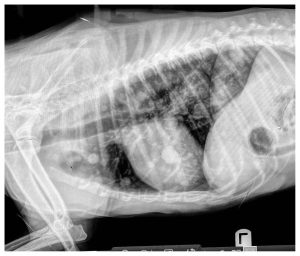
In house diagnostic imaging capabilities:
Digital X-rays (Radiology and Radiography)
- Body ‘x-rays’ (radiographs) can be used to visually evaluate the chest, abdomen, bones, spine, skull, and soft tissues.
- Depending on the situation, we may recommend (or even require) your pet to have sedation for this procedure.
- X-rays typically can be done at the time of your visit, and we can provide preliminary review of their results.
- Sometimes, we may recommend sending the x-rays to a Board Certified Radiologist for additional review.
- Digital Radiography provides quicker and safer results, limits stress to the patient, provides excellent clarity, and allows sharing of x-rays with colleagues instantly for additional consultation or referral.
- Dental ‘x-rays’ (Dental Radiographs) are taken during every dental procedure to fully evaluate the health of the teeth above and below the gum line.
- Your pet will be under anesthesia for a dental procedure, which facilitates perfectly aimed photos of the jaws, to evaluate each tooth and related structures into the jaw bone.
- If we have to remove diseased teeth, we will verify complete removal of all the roots with a post-extraction x-ray. This ensures no risk of residual disease related to the extracted tooth.
- Occasionally, the digital dental xray machine can be used for other creative purposes, such as evaluating facial bones, sinuses, and oral soft tissue structures.
Ultrasound
- Ultrasound has a long list of potential uses, and gives us much different information than x-rays. It uses sound waves to make live visual pictures of the soft tissue structures of the Yes, this is the same Ultrasound technology that is commonly thought of in human pregnancy.
- Dr. Burger has obtained additional training and certification in ultrasonography, and can perform full abdominal ultrasound services to detect abnormalities.
- We often will recommend having a Board-Certified Radiologist perform the ultrasound, to obtain more detailed information and guidance, or to assess other parts of the body such as joints, muscles, thyroid, parathyroid glands, internal lymph nodes, genitalia, adrenal glands, blood vessels, etc.
- Sometimes we may recommend (or require) your pet to be sedated for an ultrasound. Generally, the process is tolerated without much stress. Your pet will be laid gently on their back, in a soft cushion trough to support them and keep them comfortable during the procedure, which generally lasts around 10 to 20 minutes.
Other types of diagnostic imaging available via referral:
Computed Tomography (CT Scans)
- This technology is a series of rapid x-rays taken over the span of a few minutes, as the patient moves through the machine on an automated gurney. These x-rays are sent through a computer program which creates a 3-D rendering of the images.
Magnetic Resonance Imaging (MRI)
- This technology uses highly specialized technology mainly to assess the brain and spinal cord, as these structures can not be seen on x-ray because they are encompassed within bone.
- For this procedure, veterinary patients require general anesthesia due to the duration for which they have to remain perfectly still, as well as to eliminate fear and stress from the noise of the machine.
- Spinal taps (CSF taps) are another way to assess neurologic diseases, and if often performed at the time of an MRI.
Angiograms and PET scans
- These are special versions of CT and MRI scans, which include using injectable medications during the scans, to highlight very specific structures, evaluate timing of blood flow, and identify “hot spots” of cancer.
Fluoroscopy
- A specialized x-ray technology that provides a live x-ray of a patient. This is mainly used to assess issues with swallowing, regurgitation, muscular disorders of the GI tract. The patient is awake, and fed food, while the fluoroscope provides a live video of the entire swallowing process.
- This technology is also used for live video of cardiac surgeries, to visualize surgical instruments as they are traveled from a leg vein, into the heart, and into specific chambers using remote control.
No matter what diagnostic imaging your pet needs, we can help you find it.
